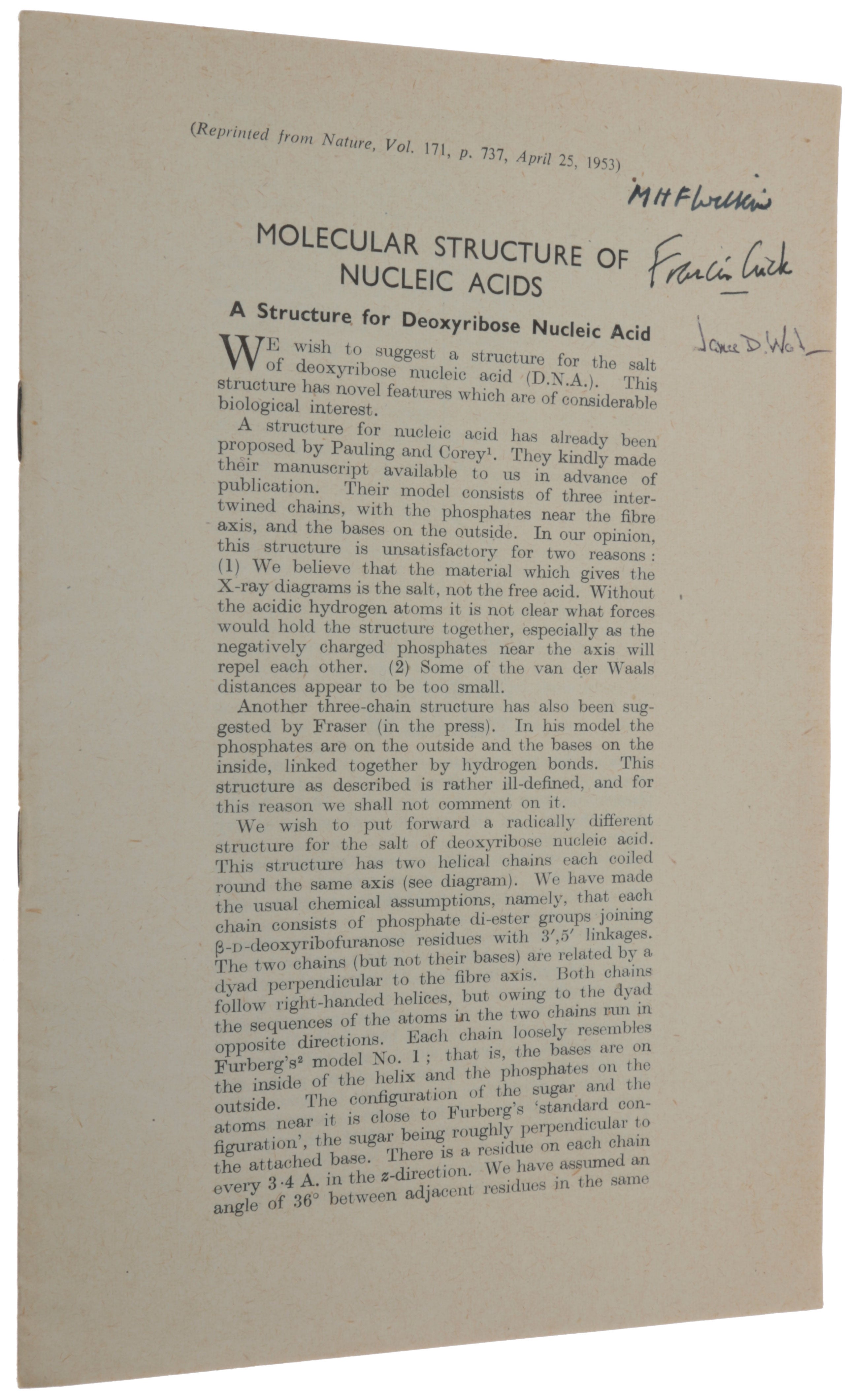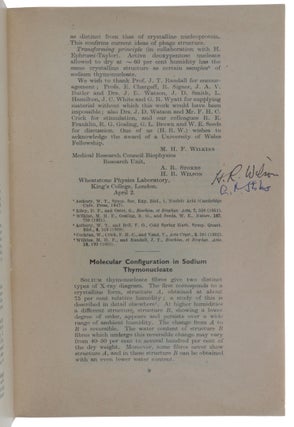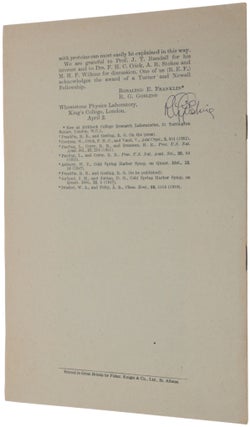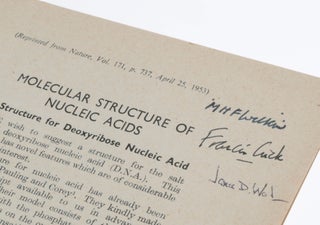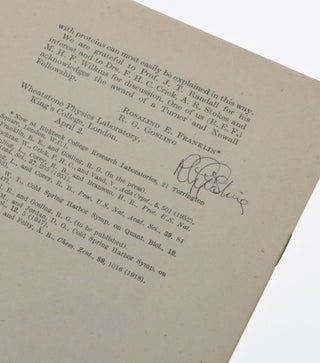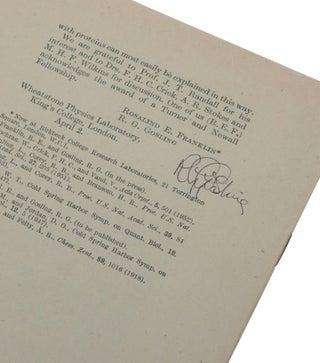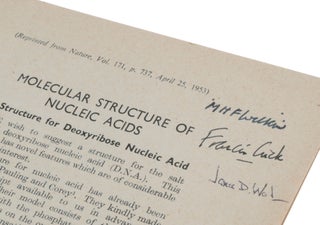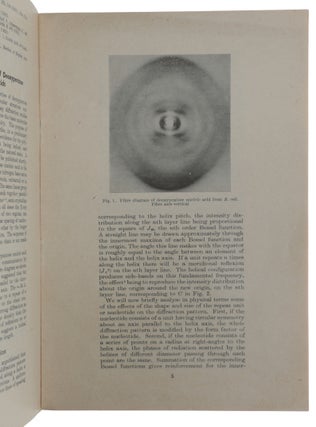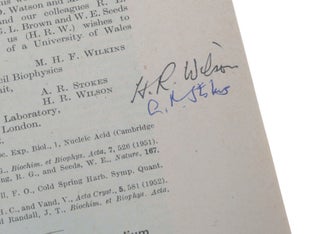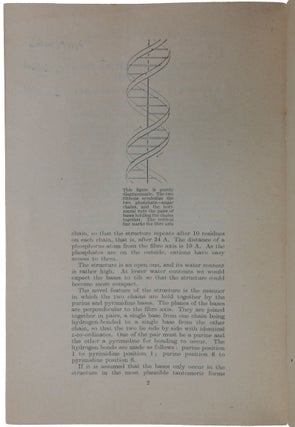‘Molecular Structure of Nucleic Acids: A Structure for Deoxyribose Nucleic Acid’; ‘Molecular Structure of Deoxypentose Nucleic Acids’; ‘Molecular Configuration in Sodium Thymonucleate’. Three papers in a single offprint from Nature, Vol. 171, No. 4356, April 25, 1953.
St. Albans: Fisher, Knight & Co., 1953. First edition, offprint, signed by Watson, Crick, Wilkins, Gosling, Stokes & Wilson, i.e. six of the seven authors. We know of no copy signed by Franklin, and strongly doubt that any such copy exists. Furthermore this copy is, what we believe to be, just one of three copies signed by six authors. One of the most important scientific papers of the twentieth century, which “records the discovery of the molecular structure of deoxyribonucleic acid (DNA), the main component of chromosomes and the material that transfers genetic characteristics in all life forms. Publication of this paper initiated the science of molecular biology. Forty years after Watson and Crick’s discovery, so much of the basic understanding of medicine and disease has advanced to the molecular level that their paper may be considered the most significant single contribution to biology and medicine in the twentieth century” (One Hundred Books Famous in Medicine, p. 362). “The discovery in 1953 of the double helix, the twisted-ladder structure of deoxyribonucleic acid (DNA), by James Watson and Francis Crick marked a milestone in the history of science and gave rise to modern molecular biology, which is largely concerned with understanding how genes control the chemical processes within cells. In short order, their discovery yielded ground-breaking insights into the genetic code and protein synthesis. During the 1970s and 1980s, it helped to produce new and powerful scientific techniques, specifically recombinant DNA research, genetic engineering, rapid gene sequencing, and monoclonal antibodies, techniques on which today’s multi-billion dollar biotechnology industry is founded. Major current advances in science, namely genetic fingerprinting and modern forensics, the mapping of the human genome, and the promise, yet unfulfilled, of gene therapy, all have their origins in Watson and Crick’s inspired work. The double helix has not only reshaped biology, it has become a cultural icon, represented in sculpture, visual art, jewelry, and toys” (Francis Crick Papers, National Library of Medicine, profiles.nlm.nih.gov/SC/Views/Exhibit/narrative/doublehelix.html). In 1962, Watson, Crick, and Wilkins shared the Nobel Prize in Physiology or Medicine “for their discoveries concerning the molecular structure of nucleic acids and its significance for information transfer in living material.” This copy is signed by all the authors except Rosalind Franklin (1920 –1958) - we have never seen or heard of a copy signed by her. In 1869, the Swiss physiological chemist Friedrich Miescher (1844-95) first identified what he called ‘nuclein’ inside the nuclei of human white blood cells. (The term ‘nuclein’ was later changed to ‘nucleic acid’ and eventually to ‘deoxyribonucleic acid,’ or ‘DNA.’) Miescher’s plan was to isolate and characterize not the nuclein (which nobody at that time realized existed) but instead the protein components of leukocytes (white blood cells). Miescher thus made arrangements for a local surgical clinic to send him used, pus-coated patient bandages; once he received the bandages, he planned to wash them, filter out the leukocytes, and extract and identify the various proteins within the white blood cells. But when he came across a substance from the cell nuclei that had chemical properties unlike any protein, including a much higher phosphorous content and resistance to proteolysis (protein digestion), Miescher realized that he had discovered a new substance. Sensing the importance of his findings, Miescher wrote, “It seems probable to me that a whole family of such slightly varying phosphorous-containing substances will appear, as a group of nucleins, equivalent to proteins”. But Miescher’s discovery of nucleic acids was not appreciated by the scientific community, and his name had fallen into obscurity by the 20th century. “Researchers working on DNA in the early 1950s used the term ‘gene’ to mean the smallest unit of genetic information, but they did not know what a gene actually looked like structurally and chemically, or how it was copied, with very few errors, generation after generation. In 1944, Oswald Avery had shown that DNA was the ‘transforming principle,’ the carrier of hereditary information, in pneumococcal bacteria. Nevertheless, many scientists continued to believe that DNA had a structure too uniform and simple to store genetic information for making complex living organisms. The genetic material, they reasoned, must consist of proteins, much more diverse and intricate molecules known to perform a multitude of biological functions in the cell. “Crick and Watson recognized, at an early stage in their careers, that gaining a detailed knowledge of the three-dimensional configuration of the gene was the central problem in molecular biology. Without such knowledge, heredity and reproduction could not be understood. They seized on this problem during their very first encounter, in the summer of 1951, and pursued it with single-minded focus over the course of the next eighteen months. This meant taking on the arduous intellectual task of immersing themselves in all the fields of science involved: genetics, biochemistry, chemistry, physical chemistry, and X-ray crystallography. Drawing on the experimental results of others (they conducted no DNA experiments of their own), taking advantage of their complementary scientific backgrounds in physics and X-ray crystallography (Crick) and viral and bacterial genetics (Watson), and relying on their brilliant intuition, persistence, and luck, the two showed that DNA had a structure sufficiently complex and yet elegantly simple enough to be the master molecule of life. “Other researchers had made important but seemingly unconnected findings about the composition of DNA; it fell to Watson and Crick to unify these disparate findings into a coherent theory of genetic transfer. The organic chemist Alexander Todd had determined that the backbone of the DNA molecule contained repeating phosphate and deoxyribose sugar groups. The biochemist Erwin Chargaff had found that while the amount of DNA and of its four types of bases – the purine bases adenine (A) and guanine (G), and the pyrimidine bases cytosine (C) and thymine (T) – varied widely from species to species, A and T always appeared in ratios of one-to-one, as did G and C. Maurice Wilkins and Rosalind Franklin had obtained high-resolution X-ray images of DNA fibers that suggested a helical, corkscrew-like shape. Linus Pauling, then the world’s leading physical chemist, had recently discovered the single-stranded alpha helix, the structure found in many proteins, prompting biologists to think of helical forms. Moreover, he had pioneered the method of model building in chemistry by which Watson and Crick were to uncover the structure of DNA. Indeed, Crick and Watson feared that they would be upstaged by Pauling, who proposed his own model of DNA in February 1953, although his three-stranded helical structure quickly proved erroneous. “The time, then, was ripe for their discovery. After several failed attempts at model building, including their own ill-fated three-stranded version and one in which the bases were paired like with like (adenine with adenine, etc.), they achieved their breakthrough. Jerry Donohue, a visiting physical chemist from the United States who shared Watson and Crick’s office for the year, pointed out that the configuration for the rings of carbon, nitrogen, hydrogen, and oxygen (the elements of all four bases) in thymine and guanine given in most textbooks of chemistry was incorrect. On February 28, 1953, Watson, acting on Donohue’s advice, put the two bases into their correct form in cardboard models by moving a hydrogen atom from a position where it bonded with oxygen to a neighboring position where it bonded with nitrogen. While shifting around the cardboard cut-outs of the accurate molecules on his office table, Watson realized in a stroke of inspiration that A, when joined with T, very nearly resembled a combination of C and G, and that each pair could hold together by forming hydrogen bonds. If A always paired with T, and likewise C with G, then not only were Chargaff’s rules (that in DNA, the amount of A equals that of T, and C that of G) accounted for, but the pairs could be neatly fitted between the two helical sugar-phosphate backbones of DNA, the outside rails of the ladder. The bases connected to the two backbones at right angles while the backbones retained their regular shape as they wound around a common axis, all of which were structural features demanded by the X-ray evidence. Similarly, the complementary pairing of the bases was compatible with the fact, also established by the X-ray diffraction pattern, that the backbones ran in opposite direction to each other, one up, the other down. “Watson and Crick published their findings in a one-page paper, with the understated title ‘A Structure for Deoxyribose Nucleic Acid,’ in the British scientific weekly Nature on April 25, 1953, illustrated with a schematic drawing of the double helix by Crick’s wife, Odile. A coin toss decided the order in which they were named as authors. Foremost among the ‘novel features’ of ‘considerable biological interest’ they described was the pairing of the bases on the inside of the two DNA backbones: A = T and C = G. The pairing rule immediately suggested a copying mechanism for DNA: given the sequence of the bases in one strand, that of the other was automatically determined, which meant that when the two chains separated, each served as a template for a complementary new chain … “Although recognized today as one of the seminal scientific papers of the twentieth century, Watson and Crick’s original article in Nature was not frequently cited at first. Its true significance became apparent, and its circulation widened, only towards the end of the 1950s, when the structure of DNA they had proposed was shown to provide a mechanism for controlling protein synthesis, and when their conclusions were confirmed in the laboratory by Matthew Meselson, Arthur Kornberg, and others. “Crick himself immediately understood the significance of his and Watson’s discovery. As Watson recalled, after their conceptual breakthrough on February 28, 1953, Crick declared to the assembled lunch patrons at The Eagle that they had ‘found the secret of life.’ Crick himself had no memory of such an announcement, but did recall telling his wife that evening ‘that we seemed to have made a big discovery.’ He revealed that ‘years later she told me that she hadn't believed a word of it.’ As he recounted her words, ‘You were always coming home and saying things like that, so naturally I thought nothing of it.’ “Retrospective accounts of the discovery of the structure of DNA have continued to elicit a measure of controversy. Crick was incensed at Watson’s depiction of their collaboration in The Double Helix (1968), castigating the book as a betrayal of their friendship, an intrusion into his privacy, and a distortion of his motives. He waged an unsuccessful campaign to prevent its publication. He eventually became reconciled to Watson’s bestseller, concluding that if it presented an unfavorable portrait of a scientist, it was of Watson, not of himself. “A more enduring controversy has been generated by Watson and Crick’s use of Rosalind Franklin’s crystallographic evidence of the structure of DNA, which was shown to them, without her knowledge, by her estranged colleague, Maurice Wilkins, and by Max Perutz. Her evidence demonstrated that the two sugar-phosphate backbones lay on the outside of the molecule, confirmed Watson and Crick’s conjecture that the backbones formed a double helix, and revealed to Crick that they were antiparallel. Franklin’s superb experimental work thus proved crucial in Watson and Crick’s discovery. Yet, they gave her scant acknowledgment. Even so, Franklin bore no resentment towards them. She had presented her findings at a public seminar to which she had invited the two. She soon left DNA research to study tobacco mosaic virus. She became friends with both Watson and Crick, and spent her last period of remission from ovarian cancer in Crick’s house (Franklin died in 1958). Crick believed that he and Watson used her evidence appropriately, while admitting that their patronizing attitude towards her, so apparent in The Double Helix, reflected contemporary conventions of gender in science” (Francis Crick Papers, ibid.) When Watson and Crick’s paper was submitted for publication in Nature, Sir Lawrence Bragg, the director of the Cavendish Laboratory at Cambridge, and Sir John Randall of King’s College agreed that the paper should be published simultaneously with those of two other groups of researches who had also prepared important papers on DNA: Maurice Wilkins, A.R. Stokes, and H.R. Wilson, authors of ‘Molecular Structure of Deoxypentose Nucleic Acids,’ and Rosalind Franklin and Raymond Gosling, who submitted the paper ‘Molecular Configuration in Sodium Thymonucleate.’ The three papers were published in Nature under the general title ‘The Molecular Structure of Nucleic Acids.’ The offprint is printed from the same type as the journal printing. The article was set in a single column of monotype. The offprint was printed from that monotype, while the journal printing was made in double columns from stereotype plates taken from the monotype. Grolier Club, One Hundred Books Famous in Medicine, 99; Dibner, Heralds of Science, 200. Garrison-Morton 256.3; Judson, Eighth Day of Creation, pp. 145-56.
8vo (210 x 140 mm), pp. 7 with two diagrams (including the double helix) and two illustrations from photographs. Stapled in self-wrappers as issued.
Item #5470
Price: $185,000.00

